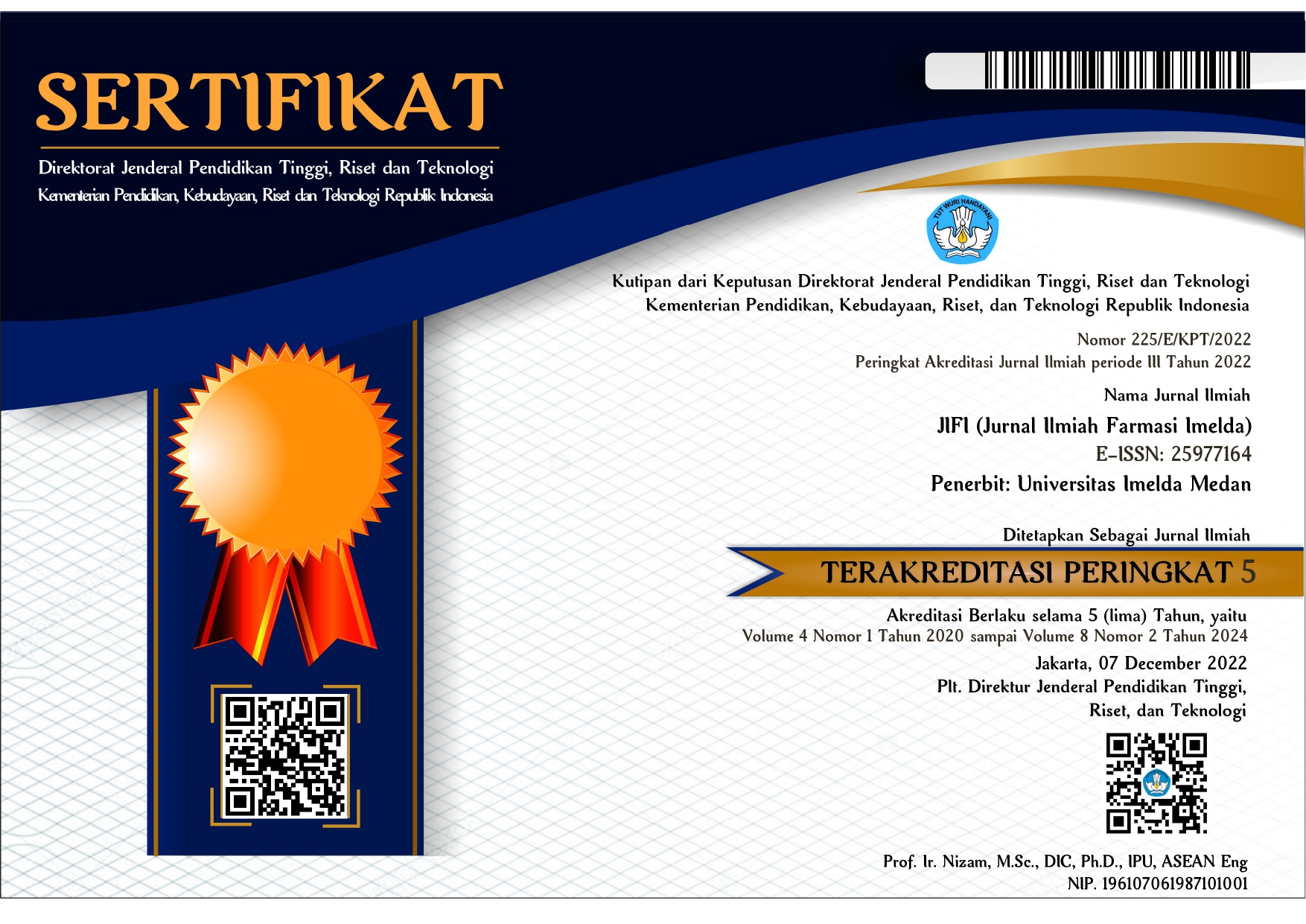INTERAKSI OBAT ANTIDIABETES DENGAN OBAT ANTITUBERKULOSIS (OAT) PADA PASIEN DIABETES MELLITUS TIPE 2 YANG TERINFEKSI TB PARU DI INSTALASI RAWAT INAP RUMAH SAKIT UMUM IMELDA PEKERJA INDONESIA MEDAN
DOI:
https://doi.org/10.52943/jifarmasi.v8i1.1716Kata Kunci:
Drug Interactions, Antidiabetic, Antituberculosis, Pulmonary TuberculosisAbstrak
Diabetes is a medical condition that can worsen the severity of pulmonary tuberculosis (TB) infection. Combining Antidiabetic Drugs with Antituberculosis Drugs (OAT) in type 2 DM patients who have pulmonary TB can cause undesirable pharmacological interactions. The aim of this study is to explain the relationship between Antidiabetic Drugs and OAT. The research design used in this study is a cross-sectional observational design, with a focus on descriptive statistical analysis. The research sample consisted of 72 patients. Data collection was carried out retrospectively using medical records and doctor's prescription forms. The Medscape (Drug Interactions Checker) tool was used for drug interaction analysis, while SPSS (Statistical Product and Service Solution) 21.0 for Windows was used for data processing. Research findings revealed that the occurrence of drug interactions between Antidiabetic Drugs and OAT varied based on gender characteristics, with 56.9% observed in men and 43.1% in women. Pharmacodynamic interactions reached 25.5% based on the mechanism of action, while pharmacokinetic interactions reached 5.7%. The remaining 68.9% were classified as unknown interactions. In contrast, minor types of drug interactions reached 68.9% in terms of severity, while moderate types of interactions reached 31.1%, and there were no significant interactions. This study concludes that the combination of antidiabetic drugs and OAT mainly causes pharmacological interactions both in the pharmacodynamic and pharmacokinetic pathways, with varying levels of severity, ranging from minimal to moderate.
Referensi
Afrianti, R., Larucy, F., & Widayana, H. (2023). Interaksi Obat Anti Tuberkulosis pada Pasien Tuberkulosis Paru. Jurnal Kesehatan Perintis (Perintis’s Health Journal), 10(1), 53–59. https://doi.org/10.33653/jkp.v10i1.912
Agustin, O. A., & Fitrianingsih. (2020). Kajian Interaksi Obat Berdasarkan Kategori Signifikansi Klinis Terhadap Pola Peresepan Pasien Rawat Jalan Di Apotek X Jambi. Electronic Journal E-SEHAD, 1(1), 1–10.
Annison, H. (2011). Book review: Book review. Criminology & Criminal Justice, 11(3), 277–278. https://doi.org/10.1177/1748895811401979
Arif, W. O. N. H., Wahyudin, E., & Djaharuddin, I. (2022). Karakteristik Pasien Tuberkulosis Paru Di Puskesmas Kota Baubau Sulawesi Tenggara. Majalah Farmasi Dan Farmakologi, 26(1), 44–47. https://doi.org/10.20956/mff.v26i1.14759
Aziz, K. K. (2019). Pengobatan Tuberkulosis Paru dan Diabetes Melitus serta Pengaruhnya terhadap Risiko Multi-Drug Resistant Tuberculosis (MDR-TB). Anatomica Medical Journal Fakultas Kedokteran Universitas Muhammadiyah Sumatera Utara, 2(1), 22–32. http://jurnal.umsu.ac.id/index.php/AMJ/article/view/2596
Halimah Ratu, R., Rahimah Bhekti, S., Saefulloh, A., Andriane, Y., & Suherian, E. (2019). Potensi Interaksi Obat Antituberkulosis dan Antidiabetes terhadap Efek Samping Obat pada Pasien Tuberkulosis-Diabetes Melitus di RSUD Al- Ihsan Bandung Potential Interactions between Anti Tuberculosis Drug and Anti Diabetes Drug with Side Effects on Tuber. Jurnal Integrasi Kesehatan & Sains (JIKS), 1(22), 59–62.
Himyatul Hidayah, & Surya Amal. (2019). Insidensi Tb Paru Kasus Baru Pada Pasien Dengan Dm Tipe 2 Di Salah Satu Rumah Sakit Swasta Cikampek. Pharma Xplore : Jurnal Ilmiah Farmasi, 4(2). https://doi.org/10.36805/farmasi.v4i2.740
Nirahua, J. B., Pandapotan, R. A., Layanto, N., Kesehatan, I., Kristen, U., Wacana, K., Dalam, I. P., Kedokteran, F., Kristen, U., Wacana, K., Mikrobiologi, D., Kedokteran, F., & Krida, U. K. (2021). Keberhasilan Pengobatan Tuberkulosis Paru dengan Komorbid Diabetes Melitus Tipe 2 Successful Pulmonary Tuberculosis Treatment with Comorbid Diabetes Mellitus Type 2. Jurnal Kedokteran Meditek, 27(3), 289–296. http://ejournal.ukrida.ac.id/ojs/index.php/Meditek/article/view/2007/2080
Reyaan, I. B. M., Kuning, C., & Adnyana, I. K. (2021). Studi Potensi Interaksi Obat pada Resep Polifarmasi di Dua Apotek Kota Bandung. Jurnal Manajemen Dan Pelayanan Farmasi (Journal of Management and Pharmacy Practice), 11(3), 145. https://doi.org/10.22146/jmpf.56931
Rohman, H. (2018). Kasus Tuberkulosis Dengan Riwayat Diabettes Mellitus Di Wilayah Prevalensi Tinggi Diabettes Mellitus. Jurnal Manajemen Informasi Kesehatan Indonesia, 6(2), 149. https://doi.org/10.33560/.v6i2.201
Solang, N. G., Wiyono, W., & Mpila, D. A. (2021). Identifikasi Interaksi Obat Potensial Pada Pasien Stroke Rawat Inap Di Rsup Prof. Dr. R. D. Kandou Manado. Pharmacon, 10(1), 639. https://doi.org/10.35799/pha.10.2021.32749
Taufik, P. (2023). Tuberkulosis Paru Dengan Diabetes Mellitus Tipe 2 Setelah Menyelesaikan Terapi Anti Tuberkulosis 9 Bulan: Laporan Kasus. 7(2), 1185–1186.
Te Brake, L. H. M., Yunivita, V., Livia, R., Soetedjo, N., van Ewijk-Beneken Kolmer, E., Koenderink, J. B., Burger, D. M., Santoso, P., van Crevel, R., Alisjahbana, B., Aarnoutse, R. E., & Ruslami, R. (2019). Rifampicin Alters Metformin Plasma Exposure but Not Blood Glucose Levels in Diabetic Tuberculosis Patients. Clinical Pharmacology and Therapeutics, 105(3), 730–737. https://doi.org/10.1002/cpt.1232
Utami, P. et al. (2020). Jurnal surya. Media Komunikasi Ilmu Kesehatan, 12(02), 70–76.
Wang, J., & Shen, H. (2009). Review of cigarette smoking and tuberculosis in China: Intervention is needed for smoking cessation among tuberculosis patients. BMC Public Health, 9, 1–9. https://doi.org/10.1186/1471-2458-9-292
Waode Dessy, Nurmainah, E. K. U. (2020). Interaksi Obat Hipoglikemia Oral (Oho) Dengan Obat Antituberkulosis (Oat) Pada Pasien Diabetes Melitus Tipe 2 Yang Terinfeksi Tb Paru. 2(April), 94–100.









